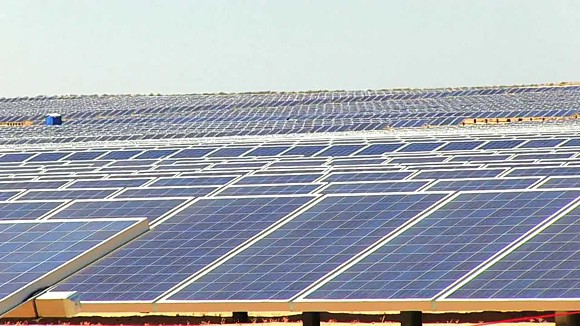Four New Large-Scale Solar Plants Added To Arizona’s APS Electricity Utility Provider Output
 January 10, 2014
January 10, 2014  Kyriaki (Sandy) Venetis
Kyriaki (Sandy) Venetis  The photovoltaic panel array of the Foothills solar power plant owned and operated by Arizona Public Service (APS). Photo courtesy of APS.
The photovoltaic panel array of the Foothills solar power plant owned and operated by Arizona Public Service (APS). Photo courtesy of APS.
Arizona Public Service, the state’s largest and longest-serving electricity utility, ended 2013 with four new large-scale solar power plants starting production in December. The facilities, located in western Arizona, have a combined generating capacity of 62 megawatts, enough to power about 15,500 APS customers.
Two of the plants – Foothills and Hyder – are owned by APS and are operating as part of the utility’s AZ Sun Program for large-scale solar facilities.
Alternatively, APS is acquiring electricity through long-term power purchase agreements from the two other plants – Badger and Gillespie – that are owned by two independent companies, PSEG Solar Source LLC, Newark N.J. and RE Gillespie 1 LLC, San Francisco, respectively.
Taking A Look At The Four Solar Plants
Foothills
The Foothills solar plant is in its second phase and is the largest project in the AZ Sun Program, with 35 megawatts total capacity. The initial phase of the 398-acre facility came online in the first quarter of 2013 near Yuma County.
Foothills uses more than150,000 photovoltaic panels to optimize energy production by following the suns path as they move on a single-axis tracking system, creating enough energy to power about 9,000 customers. Foothills is also the first solar plant on Arizona State Trust land.
APS has a 35-year lease on the land, at a cost of $10.9 million. The proceeds from the land sales and leases on the land are going to the beneficiaries of the State Land Trust, which are primarily public schools K-12.
Hyder
The Hyder solar plant is also in its second phase, located on 240 acres in eastern Yuma County, generating up to 14 megawatts of energy with more than 71,000 single-axis tracking photovoltaic panels, enough to power about 3,500 homes.
Badger 1 Solar
The Badger solar plant is a 183-acre project near Tonopah, generating up to 15 megawatts, using nearly 65,000 photovoltaic panels installed on a single-axis tracking system, with the capacity to power about 3,750 homes. While the plant is owned by PSEG, it was constructed and is managed by juwi solar inc., based in Boulder, Colo.
Gillespie
The Gillespie solar plant is a 157-acre project, generating up to 15 megawatts, near Arlington in the Gillespie Solar Energy Zone, administered by the Federal Bureau of Land Management.
The facility includes more than 70,000 single-axis tracker photovoltaic panels, enough to power about 3,750 homes. RE Gillespie is both the owner and the developer of the plant.
All of the combined plant openings cap off a record year for APS, which added about 140 megawatts of large-scale and consumer-owned solar capacity to its generating portfolio. APS said this represents its largest annual increase in solar capacity, and is triple the 150 megawatts of total capacity that it brought online in 2012.
Overall, APS has spent nearly $1 billion on solar projects across the state and now utilizes about 750 megawatts of solar capacity on its system, enough to serve the energy needs of about 185,000 customers.
In total, APS serves over 1.1 million customers in 11 counties throughout Arizona. APS is headquartered in Phoenix and is the principal subsidiary of Pinnacle West Capital Corp.
Reader comments and input are always welcomed!

Reader Comments